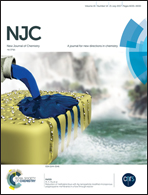Synthesis and dynamics of a novel proton transfer complex containing 3,5-dimethylpyrazole as a donor and 2,4-dinitro-1-naphthol as an acceptor: crystallographic, UV-visible spectrophotometric, molecular docking and Hirshfeld surface analyses†
Abstract
A donor, 3,5-dimethylpyrazole, forms an unusual new charge transfer (CT) complex with an acceptor, 2,4-dinitro-1-napthol, in acetonitrile when the donor and acceptor were added in a 1 : 1 molar ratio. A unique N+–H⋯O− hydrogen-bonded (H-bonded) dimer motif based on partially oxidized pyrazole and reduced 2,4-dinitro-1-napthol was constructed in the charge transfer complex. FTIR, 1H NMR, and ESI-MS spectroscopic techniques were used to ascertain the structure of the new CT complex. Thermogravimetric analysis (TGA) and differential thermal analysis (DTA) were used to determine the stability of the CT complex at different temperatures. Various important parameters such as the formation constant (KCT), molar extinction coefficient (εCT), energy of interaction (ECT), ionization potential (ID), resonance energy (RN), free energy (ΔG), oscillator strength (f), and transition dipole moment (μN) were determined using UV-visible spectrophotometry in various solvents. The successful isolation of the corresponding (1 : 1) CT complex from solution and X-ray crystallographic analysis reveal the polarized charge transfer state (ion-pair state). A 1 : 1 stoichiometry was corroborated by the Benesi–Hildebrand equation. Molecular docking studies show that the CT complex binds efficiently with the DNA receptor with a free energy of binding of −240 kcal mol−1. The N2 atom of guanine-4 (H-bonding distance = 2.835 Å), N3 atom of adenine-5 (H-bonding distance = 3.082 Å) and O3 and O4 sugar phosphate atoms of adenine-6 and -5 with H-bonding distances of 3.348 and 3.682 Å, respectively take part in hydrogen-bonding interactions. The Hirshfeld surfaces of the CT complex show surfaces that have been mapped over a dnorm range of −0.5 to 1.5 Å. The intermolecular N–O⋯H interactions appear as two distinct spikes of almost equal length in the 2D fingerprint plots in the region 2.40 Å < (de + di) < 2.45 Å, shown as a light sky-blue pattern in the full fingerprint 2D plots.



 Please wait while we load your content...
Please wait while we load your content...